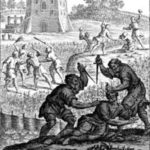We run our website the way we wished the whole internet worked: we provide high quality original content with no ads. We are funded solely by your direct support. Please consider supporting this project.

How do you explain the violent judgement of Ananias and Sapphira?
Question: You talk a lot about the violent depictions of God in the Old Testament. But what about God’s slaying of Ananias and Sapphira in the New? How do you explain that?
Answer: The same way I explain divine violence in the Old Testament. There’s simply no reason to think the cruciform hermeneutic (reading Scripture through the lens of the cross) applies only to the Old Testament. If we truly believe the cross is the quintessential revelation of what God is really like, as I do, then the cross must serve as our interpretive lens whenever and wherever we see, or believe we see, God in action. Knowing that God’s true character looks like Jesus voluntarily dying on the cross for his enemies, we will always know that something else is going on if God appears to act in ways that are contrary to this enemy-loving, non-violent character.
Now, before I apply this hermeneutic to the story of Ananias and Sapphira, I want to state upfront that I won’t be able to give a truly adequate account of this episode in my answer right now. My forthcoming book, The Crucifixion of the Warrior God, looks like it will end up at around 600 pages because I am substantiating every aspect of my thesis with a ton of scriptural evidence. Given that I am arguing for a radically different way of interpreting a significant portion of the Bible, I know the burden of proof is on me, so I’m aiming to give it. In the next couple paragraphs, however, the most I can hope to do is give a skeletal outline of what my answer would look like while leaving out almost all the evidence that would substantiate it and all of my responses to the various objections that could be raised against it.
With that proviso, how would the cruciform hermeneutic assess the Ananias and Sapphira debacle (Acts 5:1-10)? This couple said they had given all the money they’d made from a piece of property to the apostles when, in fact, they had kept some of the money for themselves. Peter first confronted Ananias, telling him that Satan had filled his heart and that he’d lied not only to people, but also to God. Ananias immediately dropped dead. His wife showed up three hours later and Peter confronted her as well. He gave her a chance to repent, but she stuck to her lie. Peter then pointed out that she had conspired with Ananias against the Lord and would now join him in the grave, at which point Sapphira fell over dead (Ac. 5:1-10).
There’s no denying that the passage depicts the death of this couple as a divine judgment. So, if the cross is the hermeneutical key to understanding God’s true character, the first question we must ask is, what does the cross reveal about the nature of Gods’ judgments? What it says, I contend, is that God judges sin by withdrawing from it, thereby allowing people to suffer its death consequences. God “delivered Jesus over” to suffer at the hands of wicked humans as well as Satan and other fallen powers. And when Jesus became our sin (2 Cor 5:21) and our curse (Gal 3:13), God the Father withdrew his presence from him, which is why Jesus experienced genuine God-forsakenness (Mt 27:46).
The cross reveals, and a wealth of biblical material confirms, that the essence of God’s “wrath” against sin is simply allowing evil to run its self-destructive course. The essence of sin is pushing God away, and since God is the source of life, sin is, by its very nature, choosing death. “All who fail to find me harm themselves; those who hate me love death,” the Lord says in Proverbs (Prov. 8:36). So too, “the wages of sin is death” (Rom. 6:23). And in the Garden the Lord told Adam “in the day you eat from it [the forbidden tree] you will certainly die” (Ge.2:17). Notice, he didn’t say, “I will certainly kill you.” Rather, the couple was removed from God’s presence, showing that their choice to sin was a choice to push God away, which is a choice to die.
In his mercy, God usually strives with people to protect them from the death consequences of their sin. There can come a time, however, when God sees that people have solidified themselves against him to the point that they cannot, or will not, yield to his love and turn from their futile attempts at living apart from a relationship with him. With a grieving heart (reflected in Jesus’ tears over Jerusalem [Lk 19:41]), God at this point grants people their wish and withdraws his protection, thereby allowing evil to run its self-destructive course (e.g. Rom. 1:24-26).
And so, as Jesus bears the sin of the world, he suffers the hellish consequences of the sin of the world as the Father withdraws and delivers him over to wicked people and fallen powers that are allowed to afflict him. And yet, by allowing evil to devour evil on the cross, God defeated evil. Satan and the powers were vanquished by the crucifixion they helped orchestrate (Col. 2:14-15; 1 Cor.2:8). The cross thus reveals, and a wealth of Scripture confirms, that evil ultimately cannibalizes itself. Allowing it to do so manifests the terrible wrath of God.
This is what I believe happened to Ananias and Sapphira. It’s first of all worth noting that, unlike some Old Testament passages, this passage does not say that God struck them dead. It simply says this couple died. And for this to happen God needed to do nothing more than withdraw his protection of them, thereby allowing the ever-present lord of death to do what he is always biting at the bit to do: namely, “kill, steal and destroy” (Jn 10:10). It’s significant that Peter points out that Ananias had allowed Satan to fill his heart (Ac 5:3), suggesting that his lying to the Holy Spirit was not an isolated evil act by a man who was otherwise blameless. It rather seems that, despite the fact that they had joined the community of faith, this couple had been pushing God away and had enslaved themselves to Satan for some time.
This episode reveals the moment God granted them their wish. In a fallen world that is saturated by agents of destruction, such as ours is, death operates like gravity. For a ball to drop, we don’t need to push it down: we simply need to release it. So too, for sinners to experience the death consequences of their decisions, God doesn’t need to slay them: he simply needs to let them go. There are times when he must do so, but as I said, Jesus reveals that God is grieving when he does.
The only other thing I’ll say is that there is no warrant for anyone to extract a universal principle out of this passage and to argue that every death is the result of God punishing someone. It’s true that all death is, in a sense, a punishment of God inasmuch as much the entire creation has been subjected to futility (Rom.8:20) because of human rebellion. But there are no grounds for applying this individually. We could only know that a specific individual died as a result of a specific judgment of God by divine revelation, which is what Peter seems to have received regarding Ananias and Sapphira. Otherwise, Jesus teaches us that it is never our place to try to discern the hand of God in the way people die. We should rather restrict our focus to our own lives, making sure that we are not heading down the road Ananias and Sapphira went down by pushing the Giver of life away.
Category: General
Tags: Cruciform Theology, Judgement, New Testament
Related Reading

How To Talk about Theology
Social media is full of theological debate. Theological arguments that formerly took months or even years to get in print, now only takes the time to write a post or 140 characters and click “publish.” Social media is great in that it makes space for all of our voices. However, it also seems to elevate…

The Violent Vineyard Owner: A Response to Paul Copan (#8)
In my previous post I addressed two of the three parables that Paul Copan argues present God in violent ways. Today I will address the third, which is the parable of a vineyard owner with hostile tenants (Matthew 21:33-41; Luke 20:9-13). This parable differs from the previous two parables. Whereas the previous parables deal with…

Can Bible Imperfections IMPROVE the Reliability of the Bible? (podcast)
Greg talks about his new book: Inspired Imperfection: How the Bible’s Problems Enhance Its Divine Authority. Episode 537 http://traffic.libsyn.com/askgregboyd/Episode_0537.mp3

The Ultimate Criteria for Theology
Theology is thinking (logos) about God (theos). It is a good and necessary discipline, but only so long as it is centered on Christ. All of our speculation and debate about such things as God’s character, power, and glory must be done with our focus on Jesus Christ—more specifically, on the decisive act by which…

Who Rules Governments? God or Satan? Part 2
In the previous post, I raised the question of how we reconcile the fact that the Bible depicts both God and Satan as the ruler of nations, and I discussed some classical ways this has been understood. In this post I want to offer a cross-centered approach to this classical conundrum that provides us with…

It’s All About the Crucified Christ
The world was created by Christ and for Christ (Col 1:16). At the center of God’s purpose for creation is his plan to unite himself to us in Christ, reveal himself to us through Christ, and share his life with us by incorporating us into Christ. We don’t know what this might have looked like…
